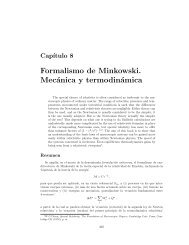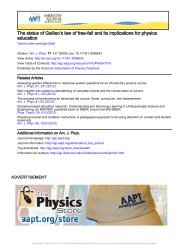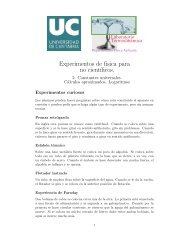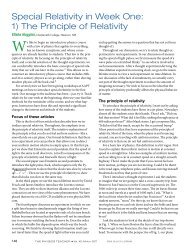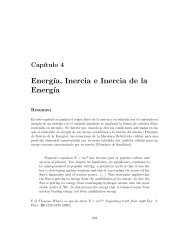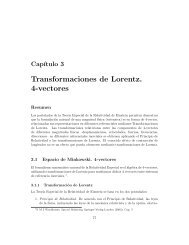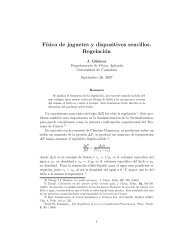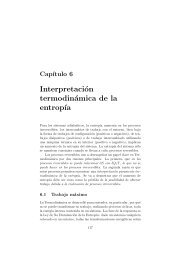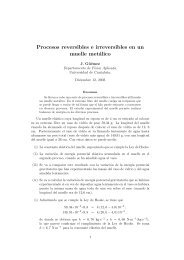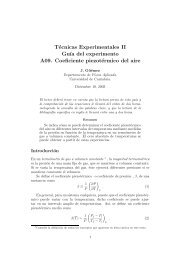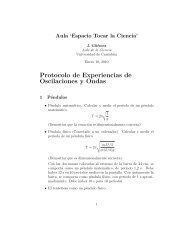Energy and the Confused Student III: Language - Loreto-Unican
Energy and the Confused Student III: Language - Loreto-Unican
Energy and the Confused Student III: Language - Loreto-Unican
- No tags were found...
You also want an ePaper? Increase the reach of your titles
YUMPU automatically turns print PDFs into web optimized ePapers that Google loves.
situation, but it is not true in general. This type of absolutestatement that does not refer to <strong>the</strong> conditionsshould be avoided because it leads students to believethat, in this case, <strong>the</strong> work-kinetic energy <strong>the</strong>orem is afundamental principle. While <strong>the</strong> statement is true fora situation in which a horizontal force is applied to anobject on a horizontal frictionless surface, it becomesfalse when <strong>the</strong> surface has friction or in any case inwhich <strong>the</strong> work done on a system does not result ina change in <strong>the</strong> speed, such as lifting a book from alower shelf <strong>and</strong> placing it on a higher shelf.ConclusionThere are many places where we can lead ourstudents into misinterpretations by careless use oflanguage. Careful <strong>and</strong> correct use of terms <strong>and</strong> definitionscan go far in improving our students’ conceptualunderst<strong>and</strong>ing <strong>and</strong> problem-solving ability. In <strong>the</strong>next article in this series, we will discuss a global approachto energy that can be used to address any energyproblem.6. As a textbook author myself, I do not specifically identifyproblematic statements in o<strong>the</strong>r authors’ textbooksin this series of articles. I do not want this series to appearas a marketing tool, but ra<strong>the</strong>r as a professionalcommunication that offers a set of suggestions for improving<strong>the</strong> teaching of energy to our students. I presentitems from several textbooks in general terms <strong>and</strong>not as direct quotes.7. J.W. Jewett, “<strong>Energy</strong> <strong>and</strong> <strong>the</strong> confused student IV: Aglobal approach to energy,” Phys. Teach., to be publishedin April 2008.8. R. Baierlein, “Does nature convert mass into energy?”Am. J. Phys. 75, 320–325 (April 2007).PACS codes: 01.40.gb, 45.00.00John W. Jewett Jr. is professor emeritus at CaliforniaState Polytechnic University. He has authored The Worldof Physics; Mysteries, Magic, <strong>and</strong> Myth <strong>and</strong> co-authoredPhysics for Scientists <strong>and</strong> Engineers, seventh edition, <strong>and</strong>Principles of Physics, fourth edition. He won <strong>the</strong> AAPTExcellence in Undergraduate Physics Teaching Award in1998; jwjewett@csupomona.eduReferences1. J.W. Jewett, “<strong>Energy</strong> <strong>and</strong> <strong>the</strong> confused student II: Systems,”Phys. Teach. 46, 81–86 (Feb. 2008).2. This statement is made under <strong>the</strong> assumption that weignore internal structure of <strong>the</strong> object. Objects withinternal structure can possess potential energy. Forexample, a spring can possess elastic potential energy<strong>and</strong> a can of gasoline can possess chemical potentialenergy. These types of energy are associated with forcesbetween components of <strong>the</strong> structure of <strong>the</strong> object,however, not with forces between <strong>the</strong> object <strong>and</strong> o<strong>the</strong>robjects.3. R.H. Romer, “Heat is not a noun,” Am. J. Phys. 69,107–109 (Feb. 2001).4. R.P. Bauman, “Physics that textbook writers usually getwrong: II. Heat <strong>and</strong> energy,” Phys. Teach. 30, 353–356(Sept. 1992).5. G.M. Barrow, “Thermodynamics should be built onenergy—Not on heat <strong>and</strong> work,” J. Chem. Educ. 65(2),122–125 (Feb. 1988).The Physics Teacher ◆ Vol. 46, March 2008 153



